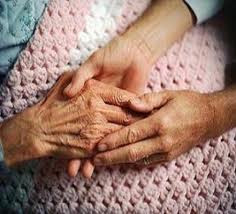 Liz: As a nurse, what kind of special perspective do you have on end-of-life in the hospital?
Liz: As a nurse, what kind of special perspective do you have on end-of-life in the hospital?
Marilyn: Once you’re in the hospital, the nurse is going to become your best friend. Because we are so much more intimately involved in the hands-on care of the patient, we can see if the patient is suffering and how much. We see the daily tasks and daily struggles. We administer the medications: for example, a lot of our patients are diabetic and they need insulin injections up to 4 times a day. If you add up all the pokes a patient is getting, it’s a lot: up to 10-12 pokes in a day, if there’s any trouble finding a vein. The nurses are the ones doing all that.
So we see our patients, we see them at the end of their congestive heart failure, or their emphysema. We see them always short of breath, always uncomfortable, and yet the aggressive treatments continue because that’s what the family wants and that’s what the patient thinks they want. But really, the conversation hasn’t been had yet that this is the end.
Nurses are the eyes for the physician and the advocate for the patient to the family. We need a lot of education out in the community; honest, earlier discussions with physicians; and nurses verbalizing the suffering of the patient.
Liz: What can doctors and nurses do to make patients, and their families, more comfortable at the end-of-life?
Marilyn: Once that decision has been made—which, I must say, is a minority of the time—it will depend on the symptoms the patient has at the end. Many times the symptom that worries nurses and families alike is shortness of breath. The patient breathes really fast and can’t talk, and pain is an issue. Putting the patient on a titrating morphine drip is a very easy order. A lot of times, we nurses don’t give the patient enough of that medicine because of our own discomfort with giving them too much. Educating nurses on that is a huge part of symptom and pain management. We need to become experts in giving the adequate amount of medicine. That’s what we’re promising the family and the patient: we promise to make your loved one comfortable, and we need to hold up to our promise.
And then there’s comforting the family. Recognizing that the family needs privacy, trying to get a private room, and then transitioning the family from one unit to another. Often we have to transfer the patient and it’s hard for families to move to a different unit, a different part of the hospital, where they don’t know the staff anymore. We want to make sure the family is physically comfortable with water, tissues, a La-Z-Boy chair. And then making keepsakes available after the patient has died: offering ribbon for locks of their hair, making a handprint clay mold, following up with how to take care of yourself after a loved one dies.
All this can be overwhelming for nurses and we’re grateful for social workers and chaplains who can take over when that happens. But with cutbacks, we don’t have that much, so more and more is falling on nurses to take on that role.
 Liz: Finally, what words of wisdom can you leave our SevenPonds readers with regarding making such end-of-life decisions for themselves or a loved one?
Liz: Finally, what words of wisdom can you leave our SevenPonds readers with regarding making such end-of-life decisions for themselves or a loved one?
Marilyn: As a patient or a family member, I would always ask the physician and the nurse: If this were your mom, how would you make the decisions? Some are comfortable giving you an honest answer and some aren’t, but it’s very telling. We see this all the time, and we’ve definitely made up our minds on what we would do. A lot of it is minimal care. Get them out of the hospital. Accept it’s the end. If you can get into a hospice situation, do it.
And then secondly, advance directive forms. There is an advance directive form under the state of California that’s kind of wordy, but the important part is where it says, in so many words, if I’m in a vegetative state or incurable disease state, I no longer wish to be on life support. Do not resuscitate me. I would like to be made comfortable in my final hours.
That type of advance directive is what a lot of people are doing, but really the conversation needs to be that, at some point in your life you’re going to be ready for natural death. This is going to be true for the elderly population. Maybe they’ve already lost a spouse, or seen their children grow up, or are proud of their grandchildren, or have just had a good life. And if something happened to them, they can allow that death to happen.
For me as a mom right now, I’m 45 and I have two kids, so I’m not going to sign something like that. I want them to resuscitate. But if I get to that age and I’ve seen my kids grow and there’s nothing more left to lose, I’m ready to go. I would like to allow natural death. In America, talking about death like that is not very common. So I would really encourage your readers to think about death in that way—allowing natural death—because it gets very complicated when you walk into an ER and the doctor says, well, you’re very sick but if we incubate you we could save your life. Shop around for your advance directives, and talk to your family about it very frankly.
Liz: Thank you for speaking with us, Marilyn!

 An Interview with Marilyn Reiss-Carradero, Pt. 2
An Interview with Marilyn Reiss-Carradero, Pt. 2


 Our Annual Seven Holiday Gifts for Someone Who Is Grieving, 2024 Edition
Our Annual Seven Holiday Gifts for Someone Who Is Grieving, 2024 Edition
 “Making Mobiles” by Karolina Merska
“Making Mobiles” by Karolina Merska
 “Hands Up to the Sky” by Michael Franti & Spearhead
“Hands Up to the Sky” by Michael Franti & Spearhead














